WELCOME to the world of PURPLE FLOWERS! Whether you’re a seasoned gardener or just starting out, FEAR not! This guide on PURPLE PERENNIALS is your BFF.
Looking to jazz up your garden with some VIBRANT colors? Need help finding the RIGHT options to add to your garden?
Well, have you considered PURPLE PERENNIALS? They’re a FANTASTIC way to add personality to your outdoor space.
At AsterGardening, we’re about making gardening EASY and FUN for everyone! So, let’s dive into the wonderful world of purple perennials.
Trust us, these FLOWERS are a BREEZE to take care of, and they come in SORTS of SHADES and SIZES in your garden.
We’ll review the most popular purple perennials and share some HANDY care tips. So, let’s GET STARTED!
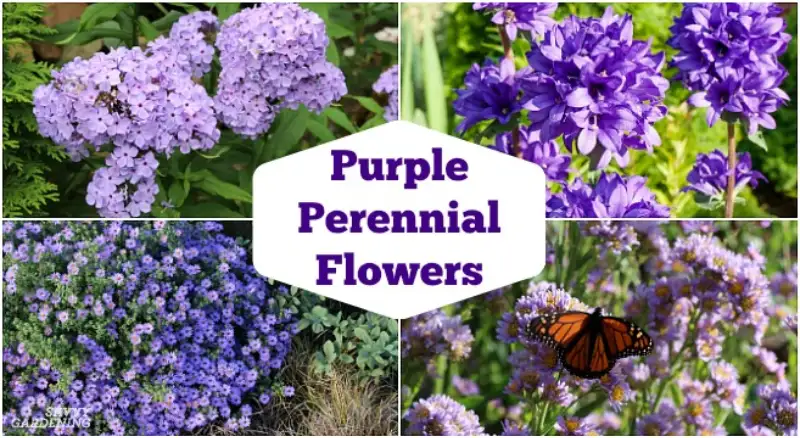
What is the best time to plant perennials?
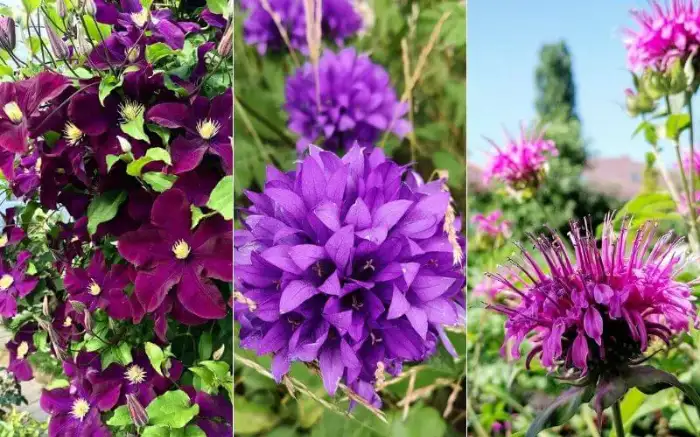
If you’re into GARDENING, you might WONDER when’s the BEST time to plant PERENNIALS.
Well, the BEST time to plant perennials is in spring or early fall. They like DAMP soil and MODERATE weather.
They’ll have enough time to grow their roots if you plant them early and late SPRING. It HELPS plants SETTLE before the SUMMER heat kicks in.
On the other hand, if you PLANT them in the FALL, they’ll go into a dormant stage. So that they get READY for the NEXT growing season.
I’ve planted perennials both in the SPRING and the FALL. I’ve FOUND that each season has its ADVANTAGES and DISADVANTAGES.
Make sure to follow the instructions on the plant LABEL. Remember to WATER them REGULARLY until they ESTABLISH themselves.
15 Magnificent Purple Perennials
I listed 15 amazing purple perennials for you to check out! TRUST ME; your outdoor space will THANK YOU for it!
1. Bearded Iris

Bearded Iris is a popular purple perennial that people are LOVING lately. This plant actually comes from EUROPE and the MEDITERRANEAN.
It has a lot of different types with different COLORS like purple, blue, bright yellow, and white. You’ll usually see German Bearded Iris BLOOM in late spring and LATE summer.
You know What’s cool? They have these LITTLE BEARDS on their PETALS that make them STAND OUT!
These purple flowers LOVE full sun to partial shade and soil that DRAINS well. And lastly, if you’re in the US, know that they’ll do BEST in USDA growing zones 3 to 10.
What’s more? These 2-3 feet-tall plants are DEER RESISTANT with dense foliage!
2. Bluebonnet
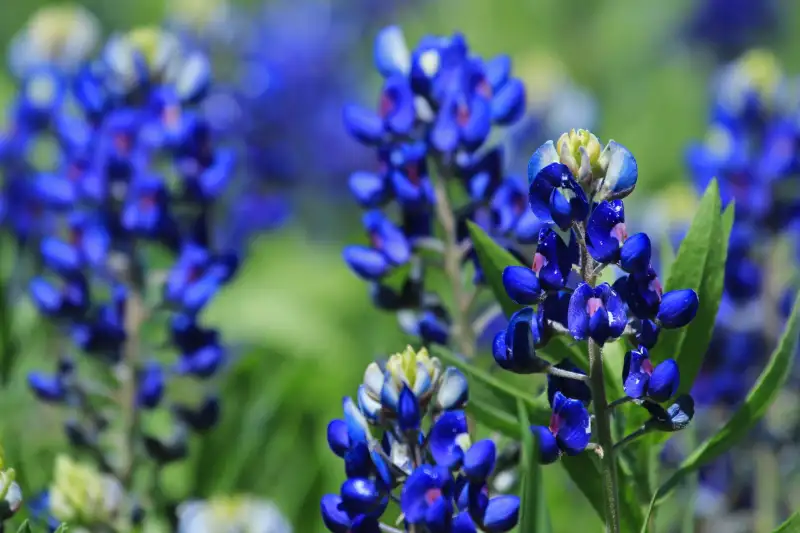
Bluebonnet is a Texas-native purple perennial plant and has a super long HISTORY. And you know what’s SUPER COOL about it?
Its lovely FLOWERS are a PRETTY light shade of blue with white tips that everybody loves!
These purple plants come in DIFFERENT varieties, each with its UNIQUE color scheme. You’ll want to PLANT them in soil that DRAINS WELL and gets full sun.
And here’s another pro tip: Bluebonnets PREFER a LITTLE BIT of ACIDIC SOIL with a pH level of around 6.0 to 7.0.
Bluebonnets are hardy little guys. They can grow just fine in USDA growing ZONES 7 to 10.
3. Butterfly Bush
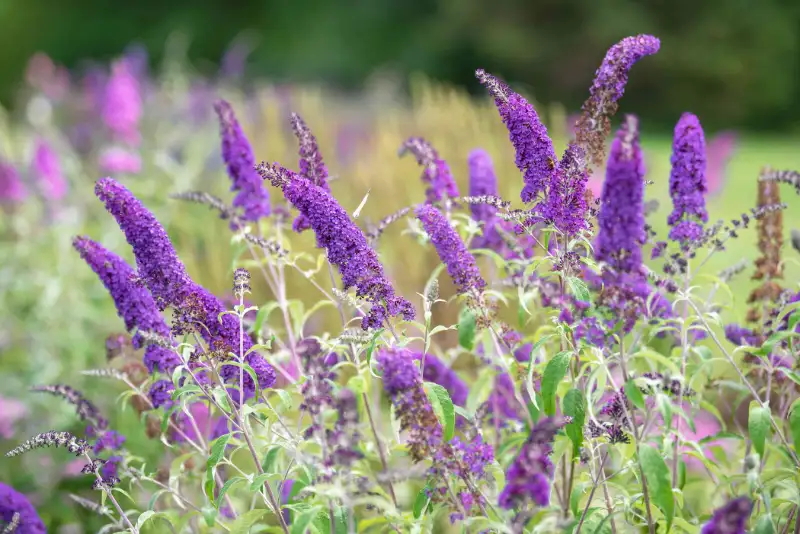
Butterfly Bush is a super cool purple perennial commonly known as BUDDLEIA. It’s ORIGINALLY from China, but now it’s EVERYWHERE!
And it’s all because of its red purple flowers in pink, purple, and white SHADES. The deep purple flowers are BEST for open lawns.
The BEST part is that it ATTRACTS butterflies and other POLLINATORS. How awesome is that? One PLUS about them is their deer-resistant nature.
So, as a fellow GARDENER, I can tell you that Butterfly Bush is pretty CHILL. This purple perennial doesn’t need a TON of attention.
Ensure that this 6-12 feet tall hardy plant gets full sun and the soil is properly DRAINED.
And here’s a tip: PRUNING the plant in the spring HELPS get even more purple BLOOMS.
4. Catmint

Catmint is an awesome purple perennial herb that smells absolutely AMAZING! It’s part of the MINT family and came from Europe and Asia.
It shows these BEAUTIFUL purple flowers when they BLOOM in late summer and fall. They are a real EYE-CATCHER.
They require soil that DRAINS WELL, like PLENTY of sunlight or PARTIAL sun.
Here’s the cool part – Catmint doesn’t need a lot of WATER. Plus, it ATTRACTS all kinds of cool POLLINATORS like bees and butterflies.
Speaking from my own experience, Catmint is a TOTAL TROOPER. I’ve GROWN this purple perennial in various spots, from FULL sun to PARTIAL shade. It has always done GREAT.
5. Hydrangea

Hydrangeas are super cool and beautiful purple flowering perennials. They are NATIVE to Asia and the Americas and are best for ground cover.
And get this – their purple BLOOMS are HUGE and totally EYE-CATCHING. They can be pink, blue, purple, or some COMBINATION of those colors! Pretty awesome.
Hydrangeas like SOIL that DRAINS well and has some SHADE. This 3-6 feet tall plant grows in USDA zone 3 to 9.
Here’s a neat trick: the purple perennial flowers’ COLOR can CHANGE depending on their SOIL pH!
6. May Night Sage
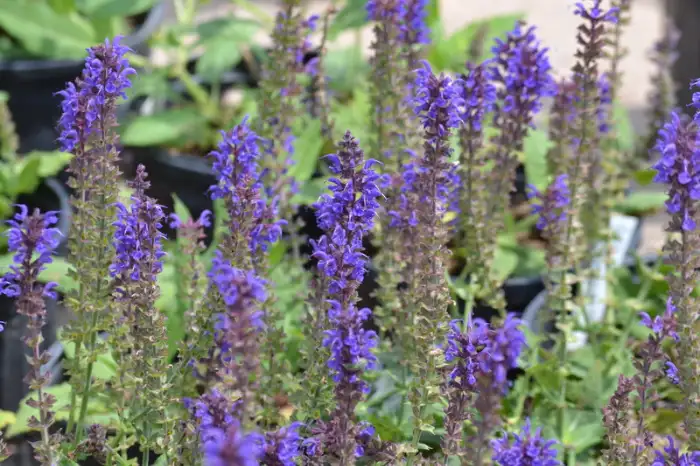
May Night Sage is a super hardy purple perennial plant originally from EUROPE. It has the most GORGEOUS blue-purple flowers and smells AMAZING too.
This plant is a tough cookie – it can take a lot of HEAT and prefers WELL-DRAINED soil. Plus, it’s great for ATTRACTING bees and hummingbirds.
I can definitely say that May Night Sage is a winner. It’s SUPER easy to care for and comes every year with BEAUTIFUL purple blooms.
And the best part? DEER doesn’t like it, so it’s a great CHOICE for deer-resistant plants.
7. Lavender

You are not a green thumb if you have not HEARD about LAVENDER. It’s SUPER FAMOUS in the plant world!
People have used it for AGES for various COOL things like perfumes and medicine. It is NATIVE to the Mediterranean and the Middle East.
To GROW these dainty purple flowers, you will need GOOD soil and FULL sun. It’ll do GREAT in USDA zones 5-9. You can ROCK your garden with this late spring to early summer flower!
The gray-green foliage is just GORGEOUS, and the SCENT is so RELAXING. People use it for Aromatherapy, and you can totally understand why!
8. Phlox
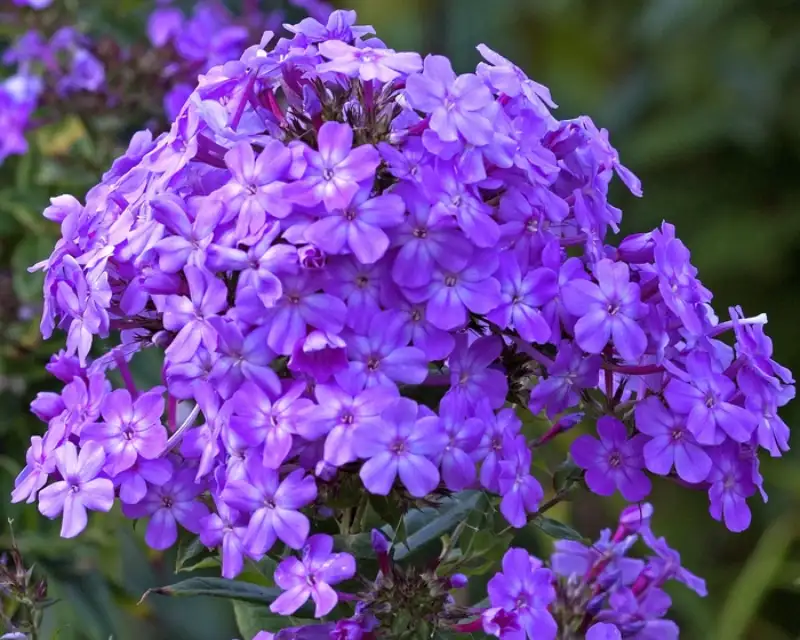
Phlox, a super cool perennial plant, ORIGINALLY came from North America. Now, you can FIND it in gardens all AROUND the world.
These tiny flowers come in tall Phlox, Creeping Phlox, and Woodland Phlox. And EACH one has its own UNIQUE colors and growth habits. How cool is that?
To PLANT Phlox in your garden, ensure PLENTY of sunlight. Provide it with WELL-DRAINING soil. That way, it will grow NICE and STRONG.
And it’s PERFECT for USDA zones 3-9. You can ADD this early summer flower to your garden no matter where you LIVE.
9. Delphinium

Delphinium is the FANCY name for bluish-purple flowers. It’s a TALL perennial that COMES from Europe and Asia.
Delphinium likes to SOAK UP the full sun and has WELL-DRAINED soil to grow its BEST. If you live in USDA zones 3-7, you’re in LUCK because Delphinium SURVIVES there.
What’s so special about Delphinium, you ask?
These TALL spikes of blue, white, and purple perennial flowers are STUNNING. If you WANT to add some HEIGHT and TEXTURE to your garden, Delphinium is your GO-TO plant.
10. Aster
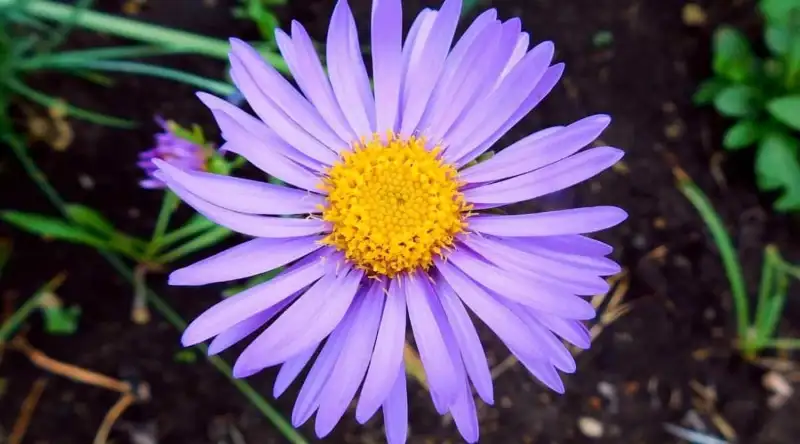
Asters are awesome light purple flowers that have been around for a long. It COMES in many DIFFERENT types, and the FLOWERS can be pink, purple, white, and more!
Plus, it’s super easy to take CARE OF. All you need is full sun and soil that DRAINS well. It PETALS look like STARS with dark green foliage!
It’s NATIVE to North America and can grow in USDA zones 3 to 8.
I SUGGEST planting these delicate flowers with other garden plants that ATTRACT bees and butterflies.
Plus, I’ve found that planting THREE or more Aster plants together looks SUPER pretty.
11. Cardoon
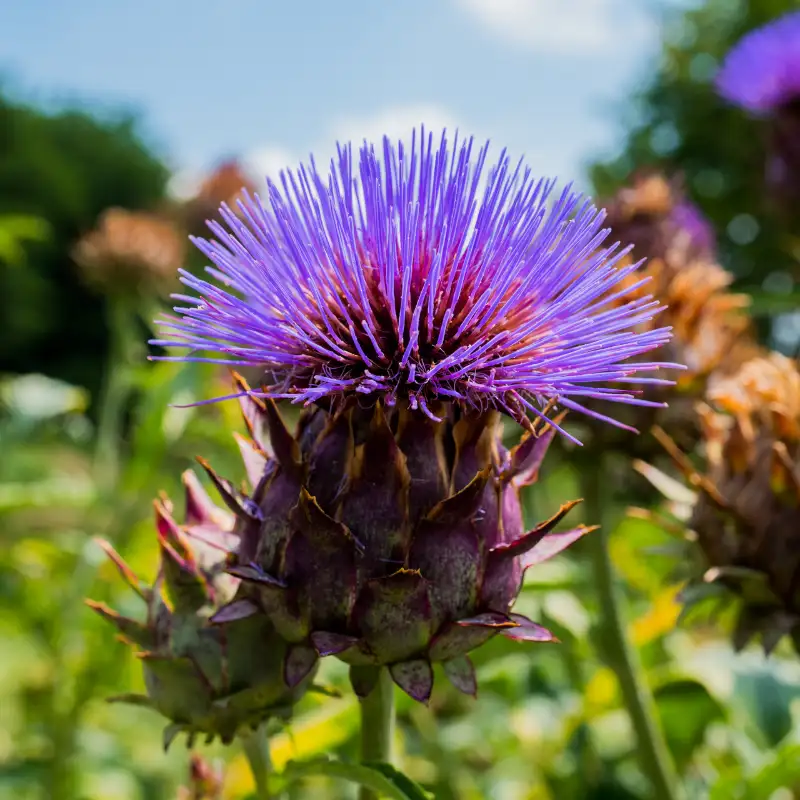
So, you WANNA know about Cardoon, HUH? Well, lemme tell ya, this PLANT is a total SHOWSTOPPER! It’s got a history that goes back to ANCIENT Greece and Rome.
Cardoon comes in a bunch of different types with flower spikes. They produce PURPLE flowers with powder puff-like BLOOMS.
They need FULL sun and have some really NICE soil to grow in. That means it NEEDS to be fertile and well-drained, YA DIG?
One of the things that makes Cardoon so special is its big, spiky leaves.
Cardoon is BEST suited for growing in USDA zones 7 to 10. If you’re into gardening, I HIGHLY RECOMMEND giving this plant a shot.
12. Cranesbill
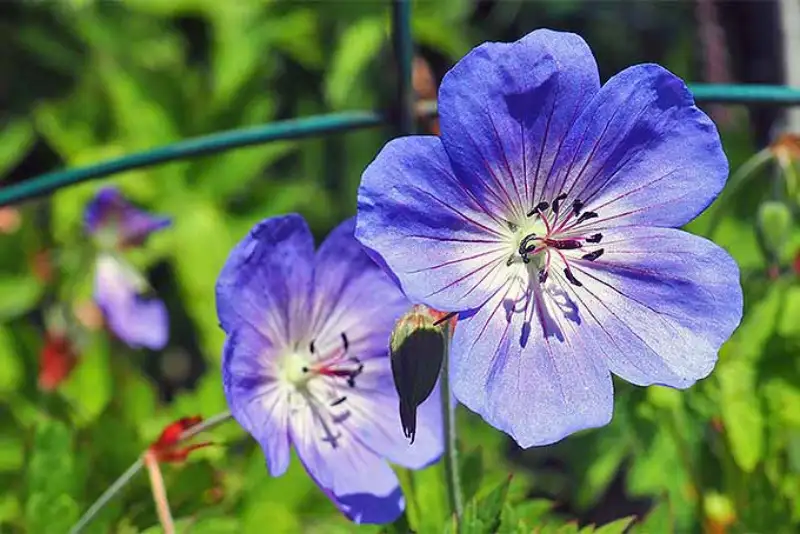
Cranesbill, also called GERANIUM, are COOL pale purple flowers with a long history!
There are many purple perennial flowers in colors like pink and white. Plus, it’s HARDY and can add a ROMANTIC VIBE with dark green leaves.
Here’s a pro tip: Cranesbill LOVES it in PARTIAL shade and soggy soil.
From my EXPERIENCE, planting Cranesbill alongside other shade-loving plants is best. It makes a great BORDER PLANT for your garden.
Plus, it’s perfect for filling in any GAPS between other afternoon shade plants.
13. Allium ‘Ambassador’

Have you heard about ornamental onions called Allium ‘Ambassador’? It’s seriously BEAUTIFUL and UNIQUE and belongs to the Allium family.
It has a REALLY COOL globe-shaped flower head that POPS up in the MIDDLE or late summer. And let me tell you, it’s no small flower. It has blue foliage that POPS.
This millenium flowering onion is a SUPER popular cultivar up to 4 feet tall. This baby can handle a RANGE from 4 to 9 in USDA growing zones.
Just make SURE to plant it in WELL-DRAINED soil in FULL sun. It will even ATTRACT some pollinators to your garden.
14. Blazing Star
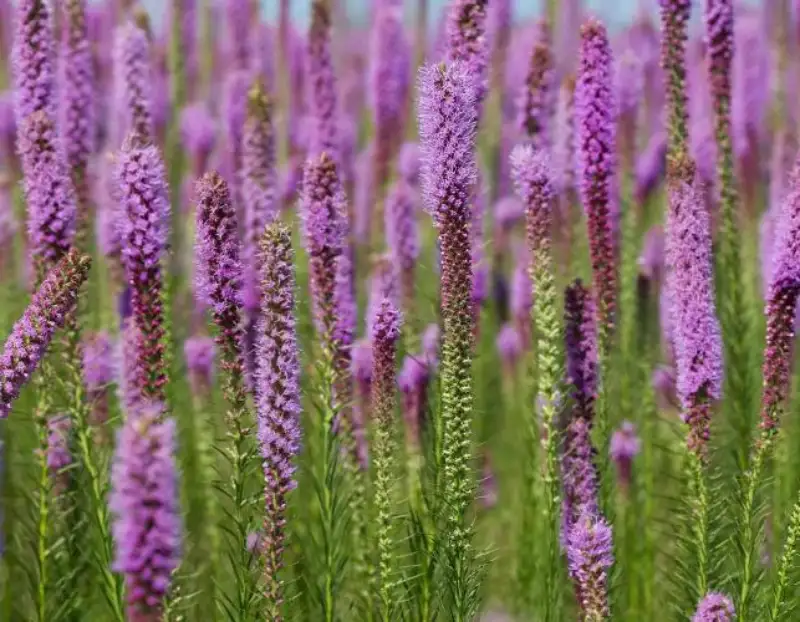
Blazing Star (Liatris) is a North American native plant. It ORIGINATED from central and eastern parts of the US.
The BEST thing about it is its GORGEOUS, TALL spikes of PURPLE flowers that BLOOM in the summer. You can also find it in white or pink to switch things up!
This showy plant LOVES well-drained soil and BRIGHT sun. So if you live in USDA growing zones 3-9, you’re in LUCK.
Not only is it SUPER EASY to take care of, but it also ATTRACTS bees and butterflies, which is always a PLUS!
15. Verbena

Verbena is a great flowering plant native to North and South America.
You’ll see pink, purple, red, and white SHADES that BRIGHTEN any garden or container.
Just ensure it’s in FULL sun and has WELL-DRAINED soil. They thrive in FERTILE soil. Plus, it’s PERFECT for USDA zones 6 to 10, which will work in many places.
And, if you’re like ME, you’ll be STOKED to hear that it’s also GREAT for bringing Hummingbirds to your garden! These are my favorite purple perennial flowers.
I always INCLUDE Verbena in my flower beds because it’s a great plant for FILLING in gaps and adding COLOR.
FAQs about Purple Perennials
1. What perennials come back every year?
Perennials are plants that come back every year. Unlike annuals, perennials live for more than one growing season. Their purple foliage dies back in the winter, only to grow the next spring again.
2. Should all perennials be cut back before winter?
It is best to cut back perennials before winter to promote new growth in the spring. However, some perennials, such as ornamental grasses, should be left uncut. It provides winter interest and shelter for wildlife.
3. Should you cut dead flowers off perennials?
Removing dead flowers (deadheading) from perennials is an essential maintenance task. It promotes more blooms and keeps the plant looking tidy. But perennials with attractive seed heads don’t need to be cut for their aesthetic value.
4. What is the hardiest perennial?
The hardiest perennial varies depending on climate and growing conditions. Some examples of the hardiest perennials are Siberian iris, blanket flower, and coneflower. These tough plants can withstand harsh weather conditions. It makes them excellent choices for cold climates.
What’s Next
So, you have LEARNED about my favorite purple perennials. The best time for planting perennials is in the FALL or EARLY spring in evenly moist soil.
This allows the plant to establish strong roots before the HOT summer months. When planting, CHOOSE the RIGHT location and soil type for the purple perennial to THRIVE.
There are many purple perennials to add some purple HUES to your garden.
Some POPULAR choices include Lavender, Purple Coneflower, Catmint, and Phlox. These perennials offer a range of colors, textures, and sizes.
Look no further to LEARN more ABOUT flowers, plant guides, and solutions to your GARDENING problems.
Visit our website to learn about CREATING a thriving, beautiful garden.
